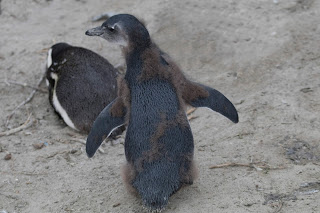 |
| This is so cool! |
Our next stop
was to Boulders Beach, home of a colony of African Penguins.
 |
| Our route |
Boulders Beach,
which is actually part of Table Mountain National Park, is a sheltered beach
made up of inlets between giant 540-million-year-old granite boulders. It is
located in the Cape Peninsula, near Simon's Town towards Cape Point.
 |
| This is why you go |
The African
Penguins, which settled there in 1982, are only found on the coastlines of
Southern Africa in South Africa and Namibia. Once extremely numerous, they
are now on the verge of extinction.
 |
| They weren't shy |
The beach is in
the midst of a residential area (in fact, we had to walk past some homes and
shops to get to the beach) and is one of the few sites where African Penguins “can
be observed at close range.”
Indeed, they are at really close range and they
are everywhere.
From just two breeding pairs in 1982, the colony has grown to
about 3,000 birds in recent years.
This is partly due to the reduction in
commercial trawling in False Bay, which has increased the supply of
pilchards and anchovy, which form part of the Penguins' diet.
 |
| Coming out of the ocean |
The most
popular recreational spot is Boulders Beach, but the Penguins are best viewed
from Foxy Beach, where boardwalks go within a
few feet of the birds.
I had thought we were at Boulders, but I think we were
actually at Foxy because we did walk the boardwalks.
It is also a
popular swimming beach, although people are restricted to beaches adjacent to
the Penguin colony. It was pretty chilly when we went, so we saw no swimmers.
With all the Penguins about, I think the beach might be a little nasty. I am not sure that I would want to swim there.
But, who cares? There are Penguins. Lots and lots of penguins.
 |
| Solitary Penguins |
 |
| Small groups of Penguins |
 |
| Baby Penguins |
 |
| Running Penguins |
 |
| Walking Penguins |
 |
| Penguin eggs |
 |
| Swimming Penguins |
 |
| Penguin pairs |
 |
| Juvenile Penguins |
 |
| Wet Penguins |
 |
| Dry Penguins |
 |
| Dancing Penguins |
 |
| And large groups of Penguins |
The African Penguin
was formerly called the Jackass Penguin -- not for its behavior, but for the donkey-like braying noise it makes.
It is flightless, with a streamlined body and wings stiffened and flattened into flippers for swimming and diving.
 |
| Cute face |
Adults weigh on average 5-8 lbs. and are 24-28 inches tall. Males are larger than the females and have larger beaks.
Their black and white coloring is a vital form of camouflage
called countershading -- white for underwater predators looking upwards and
black for predators looking down onto the dark water.
A pink gland above their
eyes helps them to cope with changing temperatures – when the weather gets hot, the body
sends more blood to these glands to be cooled by the air surrounding it, thus cooling the Penguin's body.
The African Penguin
breeds in colonies and pairs return to the same site each year. They lay two eggs
either in burrows dug in guano or scrapes in the sand under boulders or bushes.
Both parents participate in incubation for about 40 days. At least one parent
guards the chicks until about 30 days, when the chick joins up with other
chicks and both parents head out to sea to forage each day.
When penguins molt, they are unable to forage until their new feathers become waterproof, so they fast for the entire molting period, which takes about 20 days.
 |
| Losing baby fluff |
African Penguins forage in the open sea, where they pursue fish, squid and small crustaceans.
Predators in the
ocean include sharks, Cape Fur Seals and, on occasion, Orcas. Land-based
enemies include Mongooses, small cats, Leopards and Kelp Gull, which steal eggs
and newborn chicks.
 |
| Good reason to be protective |
As recently as
the mid-20th century, Penguin eggs were considered a delicacy and were collected
for sale. The practice of smashing eggs found a few days prior to gathering to
ensure that only fresh ones were sold led to a drastic decline of the Penguin
population around the Cape coast.
To make things worse, guano was removed from
rookeries to use as fertilizer, eliminating burrowing material and, thus, reducing the number of chicks.
Penguins are
susceptible to pollution by petrochemicals from spills, shipwrecks and cleaning
of tankers while at sea.
To see a video of Boulders Beach, click here.
We also saw a bunch of other things ...
 |
| A large number of Cape Lappet Moth Caterpillars |
 |
| A beautiful Cape White-Eye (wonder where it got its name?) |
 |
| A couple of Cape Wagtails |
 |
| It soon became a joke that everything is named Cape Whatever |
 |
| More Red-Winged Starlings |
 |
| And, a Hinged Tortoise |
I could have
stayed there all day, watching the birds (and, maybe I could have gotten a
picture of an African Black Oystercatcher, which I managed to miss even though
it was right in front of me) ... and the
Penguins …
 |
| So many |
... the Penguins ...
 |
| So cute |
... oh, the Penguins ...
 |
| So incredible |
... so many Penguins ...
 |
| So, so many |
But, we had to move on …
 |
| Bye! |
Trip date: August 25-September 9, 2017
































No comments:
Post a Comment